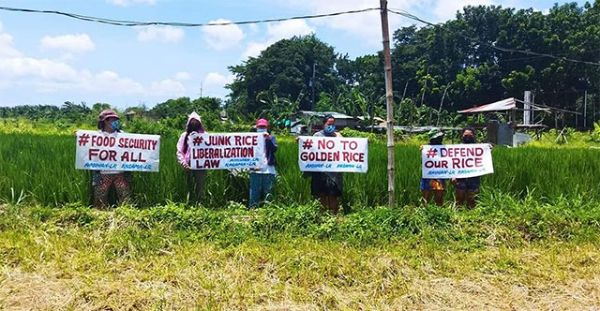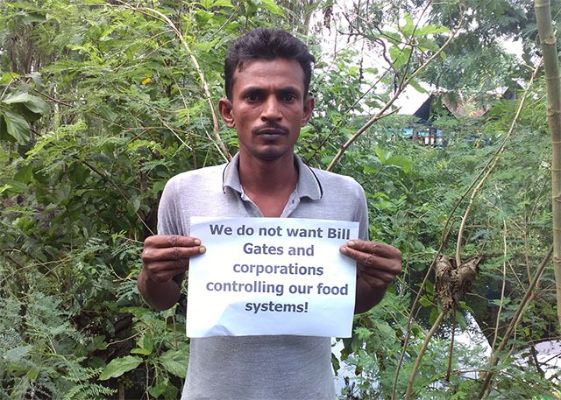Protect The World’s Rice Bowl, Stop Commercial Propagation Of GM Rice!

Stop Golden Rice! Network (SGRN) Asia condemns the approval of the commercial propagation of genetically-modified “Golden Rice” in the Philippines. The approval of GM Golden Rice (GM GR) is based on a clearly fraudulent humanitarian guise taken up by the world’s largest agrochemical and seed corporations and research institutions that support their profit agenda. GR has no scientifically proven benefits while posing clear risks to human health, livelihoods, and biodiversity.
Last July 21, 2021, the Department of Agriculture of the Philippines approved the biosafety permit for the commercial propagation of GM GR. SGRN member organizations in the Philippines question the lack of substantial review processes and independent risk assessments regarding the health, cultural and socio-economic impacts of GM GR, with authorities relying solely on documents submitted by GM GR proponents and ignoring concerns raised by opposing farmers, consumers, scientists, and food sovereignty advocates.
GM GR’s railroaded approval in the Philippines will serve to justify the approval of GM rice elsewhere in Asia. Home to more than 50,000 rice varieties, the looming adoption and commercialization of Golden Rice in Asia endangers the world’s center of rice heritage and diversity. In a region where 90% of the world’s rice is produced and consumed, Golden Rice also paves the way for the introduction of unsafe, genetically-modified staple food into the diets of hundreds of millions of people. A dream come true for multinational corporations aiming to expand markets for genetically modified crops and further tighten their control over global food systems, it spells disaster for small-scale farmers who cannot afford to lose local and traditional rice seeds to genetic contamination. It portends doom for consumers who can no longer be certain if the rice they eat every single day will be safe.
For over two decades, GM GR proponents tried to sell the narrative of Vitamin A “fortified” Golden Rice as a panacea to Vitamin A Deficiency. But evidence has consistently pointed to the contrary. Now in its fourth generation of development, the average beta-carotene (the precursor to Vitamin A) of Golden Rice (GR2E) is a measly 3.57 g/g. Studies have also shown how the beta-carotene content in GR2E degrades significantly after weeks in storage (rice is usually stored for several months before consumption) and further loss during cooking.
GM GR has also failed miserably in test fields. In India, the crop was stunted, had root defects, and yielded only one-third compared to non-GM varieties. In Indonesia, IRRI’s own studies also showed low quality agronomical results. The experiences of small farmers across the world show how expensive, input-driven technologies, especially when they fail, drive them into deeper debt and bankruptcy. They do not need another GM crop forced upon them at a time when they have not even recovered from the socio-economic impacts of COVID-19.
But the biggest absurdity of GM GR is how it is being pushed in Asian countries that are mega-diverse (particularly India, Philippines, Bangladesh and Indonesia) countries where there are numerous, readily accessible plants naturally rich in beta-carotene. To illustrate, one sweet potato has almost five times the beta-carotene level of GM GR. One carrot has the same amount of Vitamin A found in nearly 4 kilograms of cooked GM rice. Furthermore, a recent study in India articulated emerging concerns that food fortification—the latest direction of GM crops—may cause harm by putting a “part of the population at risk of exceeding the tolerable upper limit of intake at which adverse events begin to occur.”

We at SGRN Asia stand by our assertion that the solution to hunger and malnutrition lies in comprehensive approaches that ensure people’s access to diverse sources of nutrition. Securing small farmers’ control over resources such as seed, appropriate technologies, water and land is the real key to improving food production and eradicating hunger and malnutrition. The promotion of a single-crop diet as a false, reductionist solution to malnutrition will follow the Green Revolution’s legacy of dominant crops destroying diet diversity and biodiversity in farmlands.
GM GR would hasten the complete shift of control over seeds from farmers to multinational corporations, which are currently earning billions of dollars on the privatization of seeds. It should be noted that the Swiss agrochemical and seed giant Syngenta, acquired by ChemChina, holds full commercial rights over GM GR. With its development backed by millions of dollars infused by the Bill and Melinda Gates Foundation—the world’s number one purveyor of GM crops—it is clear that the approval of GM GR will unlock the new generation of “biofortified” GM crops already in the pipeline for the rest of the world, such as GM Vitamin A banana in Uganda and Golden Potatoes. Corporations stand to benefit immensely should these GM crops make it to full commercialization.
We call on the farmers community to reject planting GM Golden Rice in our fields and global community to support the continuing fight to keep GM Golden Rice and other GM crops off our fields and our plates, to expose these profit-motivated false “solutions” to hunger and malnutrition, and to advance genuine food systems transformation anchored on the right to food, peasant’s rights to land and resources, community-led agroecology and people’s food sovereignty.
Watch the press conference of Stop Golden Rice! Network
Resources:
GRAIN and MASIPAG (2018). Don’t get fooled again! Unmasking two decades of lies about Golden Rice.
GRAIN (2018). Golden Rice and Biofortification: Development and Challenges.
CBAN Factsheet (2014). “Golden Rice” GM Vitamin A Rice.
Stop Golden Rice! Network (SGRN) Asia is made up of 26 organizations and regional formations in the Philippines, Thailand, Japan, Indonesia, Bangladesh, India, Sri Lanka and Malaysia.


 Global Jews for Palestine: Jewish Organisations' Passover Statement, After 40 Days Of Starvation
Global Jews for Palestine: Jewish Organisations' Passover Statement, After 40 Days Of Starvation APEC: Stronger Immunization Policies Needed As Vaccine Confidence Falls
APEC: Stronger Immunization Policies Needed As Vaccine Confidence Falls 350.org: Indigenous Groups From The Pacific, Brazil & Canada Hand Demands To COP30 Presidency To End Fossil Fuels
350.org: Indigenous Groups From The Pacific, Brazil & Canada Hand Demands To COP30 Presidency To End Fossil Fuels Conservation International: Conservation International Expedition Reveals Ecosystem Recovery In Tokelau
Conservation International: Conservation International Expedition Reveals Ecosystem Recovery In Tokelau UN Special Procedures - Human Rights: UN Expert Urges States To Finance Inclusive And Sustainable Development, Not A War Economy
UN Special Procedures - Human Rights: UN Expert Urges States To Finance Inclusive And Sustainable Development, Not A War Economy Amnesty International Aotearoa NZ: Global - Recorded Executions Highest Since 2015
Amnesty International Aotearoa NZ: Global - Recorded Executions Highest Since 2015